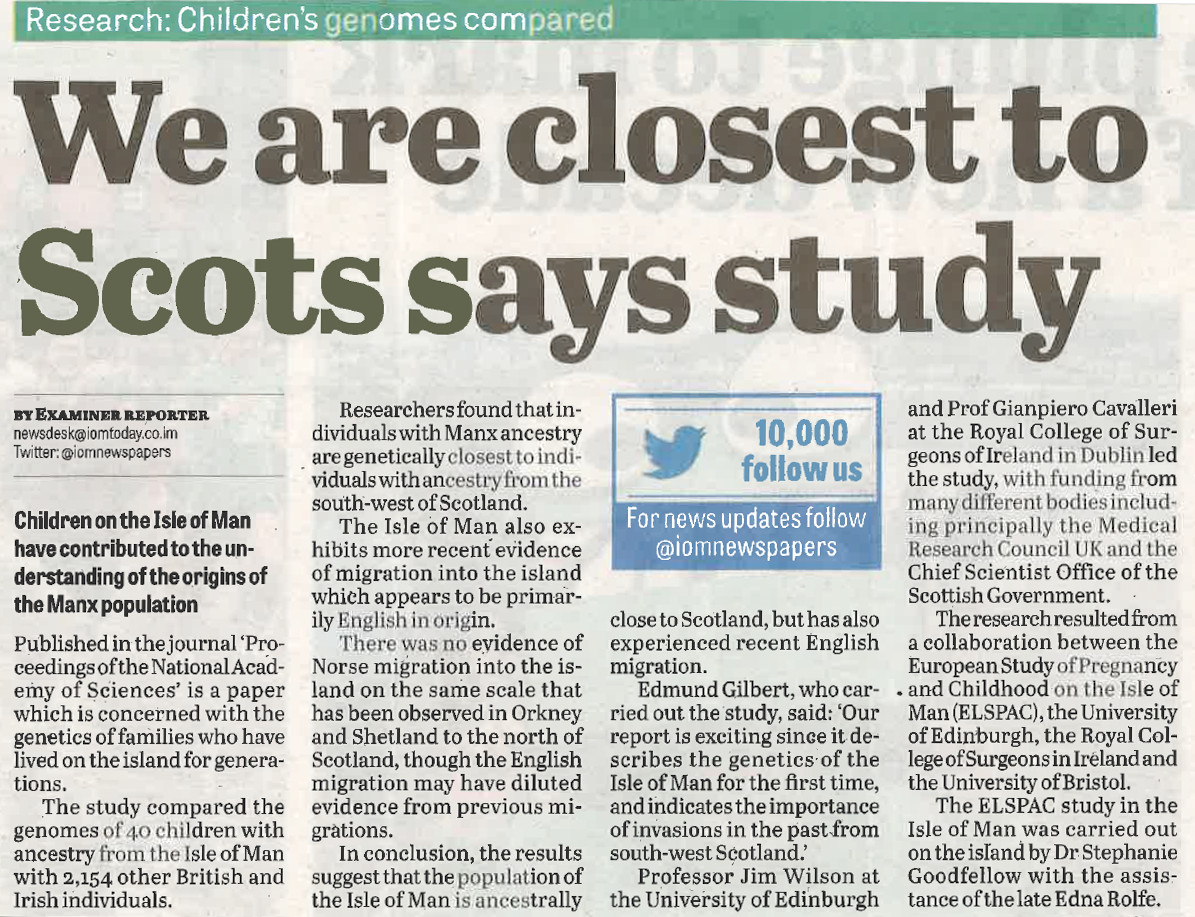ELSPAC in the Isle of Man
ELSPAC in the Isle of Man is a birth cohort study which followed the families of children born on the island in the early 1990s. It's one of a group of similar studies set up across Europe at that time, known as the European Longitudinal Study of Pregnancy and Childhood (ELSPAC), which includes the study based in Brno (previously in Czechoslovakia, now in the Czech Republic) and the ALSPAC study in Bristol. Data collection continued on the Isle of Man until 2008, by which time a wealth of information had been gathered.
ELSPAC in the news again
The following report about the study of Manx DNA appeared in the Isle of Man Examiner on 7 January 2020:

Genetic ancestry on the island
Children on the Isle of Man have contributed to the understanding of the origins of the Manx population.
Published in the prestigious journal ‘Proceedings of the National Academy of Sciences’ is a paper which is concerned with the genetics of families who have lived on the island for generations.
It has resulted from a collaboration between the European Study of Pregnancy and Childhood on the Isle of Man (ELSPAC), the University of Edinburgh, the Royal College of Surgeons in Ireland and the University of Bristol.
The study compared the genomes of 40 children with ancestry from the Isle of Man with 2,154 other British and Irish individuals. Researchers found that individuals with Manx ancestry are genetically closest to individuals with ancestry from the south-west of Scotland. The Isle of Man also exhibits more recent evidence of migration into the island which appears to be primarily English in origin. There was no evidence of Norse migration into the island on the same scale that has been observed in Orkney and Shetland to the north of Scotland, though the English migration may have diluted evidence from previous migrations.
In conclusion, the results suggest that the population of the Isle of Man is ancestrally close to Scotland, but has also experienced recent English migration.
Edmund Gilbert who carried out the study said “Our report is exciting since it describes the genetics of the Isle of Man for the first time, and indicates the importance of invasions in the past from south-west Scotland.”
Professor Jim Wilson at the University of Edinburgh and Prof Gianpiero Cavalleri at the Royal College of Surgeons of Ireland in Dublin led the study with funding from many different bodies including principally the Medical Research Council UK and the Chief Scientist Office of the Scottish Government.
Further details of the genetic study can be obtained from Professor Wilson (jim.wilson@ed.ac.uk).
The ELSPAC study in the Isle of Man was carried out on the Island by Dr. Stephanie Goodfellow with the assistance of the late Edna Rolfe. Information on ELSPAC can be obtained from Barbara Corlett, who took part in the study, and is a member of its Governance Committee (mousecorlett@gmail.com; corlett.mona@manx.net ).
Further information on the ELSPAC study is available on the study website: bristol.ac.uk/isle-of-man.
The paper can be found at https://www.pnas.org/content/early/2019/08/27/1904761116
ELSPAC in the news
An article about ALSPAC in the Isle of Man appeared in the press on the island in September 2018. Follow the link below to read it...
Does the acronym ELSPAC mean anything to you? If so, you are probably one of 800 parents who took part in a birth cohort study, which followed the families of children born in the Isle of Man in the early 1990s, writes Sue Woolley: http://www.iomtoday.co.im/article.cfm?id=42540
Newsflash!
Read about how ELSPAC in the Isle of Man is contributing to an important DNA database covering the whole of the British Isles and Ireland.
The end of an era
In 2014, following the retirement of study director Stephanie Goodfellow, the ownership of the study and its data passed on to the University of Bristol. More details about the transfer, the people involved in running the study, and a farewell message can be viewed on the change of ownership page.
What next?
A profile of the cohort was published in 2012, and provides detailed information on how the study was set up and data collected. We aim to make these data available to bona fide researchers, allowing the information collected to be used to its full potential. If you are interested in making use of this resource, please see our data access page for more details.
Study participants
We would also love to keep in touch with study participants. Your hard work in completing questionnaires and attending clinics allowed this collection of data to be built, and is hugely appreciated. In the years since the last questionnaires were sent out many of you will have moved house or changed name. Please see the panel to the right for more information about contacting us.
Contact us
If you have any queries or comments and wish to contact us, we can be reached by e-mail at elspac-iom@bristol.ac.uk.

Get in touch
Over the years we've lost touch with many of the participants in this study. We would love to hear from any study members – mums, dads or children – to hear what you're up to now. If you're happy for us to get in touch please email us your up-to-date contact details using the link below, also telling us the names and dates of birth of the study mum and child. We need this information so that we can correctly identify you on the database.